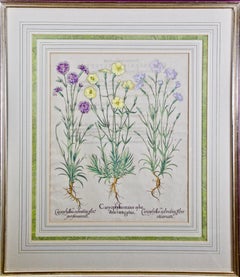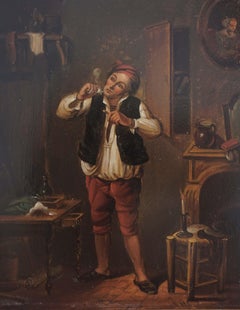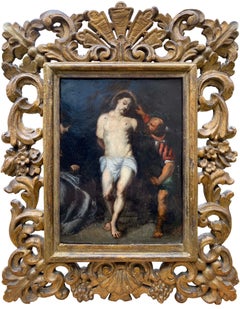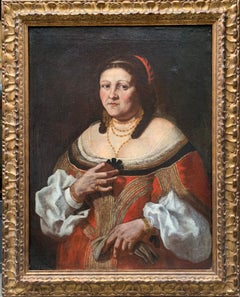17th Century Art
to
525
598
278
211
218
320
Overall Width
to
Overall Height
to
7,528
21,289
158,653
232,742
1,965
2,233
4,900
6,407
5,807
13,247
19,622
25,632
18,253
13,558
5,377
700
112
9
2
2
1
1
1
1
846
702
14
1,199
623
471
336
308
172
145
115
111
92
92
89
83
81
77
48
40
39
34
33
874
840
392
352
348
67
32
28
25
24
878
346
1,235
347
Period: 17th Century
Besler Hand Colored Botanical Engraving of Wood Pink & Cottage Pink Flowers
Located in Alamo, CA
A 17th century hand-colored copper plate engraving entitled "Caryophyllus Maior Sylve Strisvarie Gatus" (Wood Pink & Cottage Pink Flowers) from Basilius Besler's landmark work, Hortus Eystettensis (Garden at Eichstatt), first published in 1613 in Eichstatt, Germany near Nuremberg and later in 1640 and 1713.
This engraving is presented in a silver and gold-colored wood frame with a green edge and three elaborate cream-colored French mats...
Category
Old Masters 17th Century Art
Materials
Engraving
Christ Angels Pietro Da Cortona Paint Oil on canvas Old master 17th Century Art
Located in Riva del Garda, IT
Christ surrounded by angels in the desert
Circle of Pietro da Cortona, born as Pietro Berrettini (Cortona 1597 - Rome 1669)
Oils on canvas (66 x 50 cm. - in frame 80 x 64 cm.)
The ...
Category
Old Masters 17th Century Art
Materials
Oil
$8,557 Sale Price
20% Off
Shepherd with Animals and Riders in a Landscape - Dutch 17thC art oil painting
Located in Hagley, England
This superb Dutch Old Master oil painting is attributed to Pieter Bodding van Laer. Painted circa 1635 during the Dutch Golden Age the composition depicts a number of figures and ani...
Category
Old Masters 17th Century Art
Materials
Oil
$15,272 Sale Price
20% Off
17th Century Genre Painting -- The Pipe Smoker
Located in Soquel, CA
Wonderful genre painting from 18th Century of pipe smoker. Signed lower right edge with monogram "I I E". Oil paint on copper. Condition: good: minor wear/rubbing from frame's rabbet...
Category
Realist 17th Century Art
Materials
Copper
The Flagellation of Christ, Old Master, Flemish School, Oil on copper
Located in Knokke, BE
The Flagellation of Christ
Old Master
Flemish School
17th century
Medium: Oil on copper
Dimensions: Image size 22 x 17 cm, frame size 39 x 31 cm
Category
Baroque 17th Century Art
Materials
Copper
$12,938 Sale Price
30% Off
Portrait Of A Noblewoman. Attributed To Carlo Ceresa. About 1640.
By Carlo Ceresa
Located in Firenze, IT
Portrait of a noblewoman.
Attributed to Carlo Ceresa. (1609 - 1679, Bergamo)
Oil on canvas.
Size cm 110x86,5cm with frame
Around 1640.
This portrait depicts a middle-aged woman with great realism, typical of Lombard and Bergamo painters in particular. Carlo Ceresa, probable author of this unsigned painting, had studied with Daniele Crespi...
Category
Baroque 17th Century Art
Materials
Canvas, Oil
$2,690 Sale Price
43% Off
Flowers Still-life Scacciati 17th Century Paint Oil on canvas Old master (2/3)
Located in Riva del Garda, IT
Andrea Scacciati (Florence 1642-1710)
Composition of flowers within embossed vase (2 of 3)
oil on canvas
130 x 90 cm
In antique frame 145 x 105 cm.
Work with expertise by Prof. Emi...
Category
Old Masters 17th Century Art
Materials
Oil
$13,641 Sale Price
20% Off
17th Century By Guidotti aka Cavalier Borghese Salomé and the Baptist Oil/canvas
Located in Milano, Lombardia
Cavaliere Paolo Guidotti, also known as il Cavalier Borghese (Lucca, Italy, 1559 - 1629)
Title: Salomé and the Baptist
Medium: Oil on canvas
Dimensions: without frame 90 x 68.5 cm -...
Category
Old Masters 17th Century Art
Materials
Canvas, Oil
French School, 17th Century, 'Portrait of the Marquise de Grugieres', oil canvas
Located in Petworth, West Sussex
French school, 17th Century
Portrait of the Marquise de Grugieres
Oil on canvas
26.1/4 x 21.5/8 in. (66.7 x 54.8 cm.)
In a gilded composite frame, later production (possible early 1...
Category
Old Masters 17th Century Art
Materials
Canvas, Oil
Banquet Belshazzar Francken II Paint 17th Century Oil on canvas Old master
Located in Riva del Garda, IT
Frans Francken II (Antwerp, 1581–1642) workshop/circle
The Banquet of Belshazzar
Oil on canvas 98 x 115 cm In frame 121.5 x 141.5 cm
The painting, which shows us a sumptuous...
Category
Old Masters 17th Century Art
Materials
Oil
European Portrait of a Priest
Located in Milford, NH
A fine European portrait of a priest, oil on canvas, probably dating to the 17th or 18th century, unsigned, with original stretcher, minor surface losses and damage, craquelure, edge...
Category
17th Century Art
Materials
Canvas, Oil
Feast in the Garden of Love, 17th century Antwerp, Louis de Caullery
Located in PARIS, FR
Louis de Caullery (1582-1621)
Antwerp School early 17th century
Oil on oak panel
Dimensions: h. 51 cm (20.08 in), w. 43 cm (16.93 in)
Ebonized wooden frame
Framed: h. 67 cm (26.38 in...
Category
Old Masters 17th Century Art
Materials
Oil, Wood Panel
The Flagellation of Christ, 17th Century Italian School Old Master
Located in Blackwater, GB
The Flagellation of Christ, 17th Century
Italian School
Fine huge 17th Century Italian Old Master depiction of the Flagellation of Christ, oil on canvas. Excellent quality full len...
Category
17th Century Art
Materials
Canvas, Oil
$3,150 Sale Price
30% Off
Portrait of a Gentleman, David Erskine, 13th Laird of Dun, Wearing Armour c.1700
Located in London, GB
The gentleman in this exquisite oil on canvas portrait, presented by Titan Fine Art, is shown with the grandiloquence characteristic of the English School of painting. He is portray...
Category
Old Masters 17th Century Art
Materials
Oil, Canvas
Fine 17th Century French Old Master Oil Painting Nude Lady Doves & Cherubs
Located in Cirencester, Gloucestershire
Mythological Figures in Classical Sunset Landscape
French School, 17th century
oil on canvas, framed
framed: 20 x 23.5
painting: 13.5 x 17 inches
provenance: private collection, Engl...
Category
Old Masters 17th Century Art
Materials
Oil
Italian School, Nicolo Grassi, 18th, Worship of Venus, The Venus Sacrifice, Amor
Located in Greven, DE
Italian School, 18th Century, Circle of Grassi,
This old master drawing is drawn in the late-Baroque or Rococo style.
It depicts a woman worshipping Venus/ preparing a sacrifice for ...
Category
Baroque 17th Century Art
Materials
Handmade Paper
$1,645 Sale Price
40% Off
17th century oil on canvas painting 'Ectasy of Saint Cecilia'
Located in Oostende, BE
This unique painting is called 'Ectasi of Saint Cecilia' and was painted by the Italian painter Bartolomeo Guidobono, nickname The Savona Priest (1654-1709)
Work of great pictorial ...
Category
Italian School 17th Century Art
Materials
Canvas
Old Master Portrait of a Gentleman - British 18th century oil painting
By Michael Dahl
Located in Hagley, England
This stunning 18th century Old Master portrait oil painting is attributed to Swedish born, England based artist Michael Dahl. Painted circa 1690 it is a sumptuous half length portrai...
Category
Old Masters 17th Century Art
Materials
Oil
$10,363 Sale Price
20% Off
Flemish Old Master, Study of Donkey Carriage, 17th Century, Sanguine Drawing
Located in Greven, DE
This drawing shows several studies of a donkey with a carriage. Its style is close to Flemish 17th century artists. On the passepartout one reads "Mathias Scheyer/ Jacob Weyer", both...
Category
Baroque 17th Century Art
Materials
Chalk, Handmade Paper
$858 Sale Price
20% Off
Drawing Ink 16th 17th Flemish DE VOS Religious Martyrdom of James The Great
Located in PARIS, FR
Flemish school from the beginning of the 17th century (Circle of Martin DE VOS) Drawing Pen and wash 38 x 32 cm (58 x 52 cm with the frame) Inscription "Martin de Vos" Excellent cond...
Category
Old Masters 17th Century Art
Materials
Handmade Paper
$2,384 Sale Price
20% Off
The Beheading of the King of England; Enthauptung des Königs in England
Located in Middletown, NY
The execution of Charles I (1600-1649) at Whitehall, January 30th 1649, in front of the Banqueting House. The executioner holding the head of Charles up to the crowd below.
Engravin...
Category
Old Masters 17th Century Art
Materials
Laid Paper, Engraving
17th Century By Hendrick Van Somer Saint Jerome Oil on Canvas
Located in Milano, Lombardia
Hendrick van Somer o Someren o de Somer (Lokeren, Belgium, 1607 - Naples, Italy, 1656)
Title: Saint Jerome
Medium: Oil on canvas
Dimensions: without frame 91 x 72 cm - with frame 108...
Category
Old Masters 17th Century Art
Materials
Canvas, Oil
$23,276 Sale Price
20% Off
Still Life of Flowers in vase on Ledge - Dutch 17thC Old Master art oil painting
Located in Hagley, England
This stunning 17th century Dutch Old Master Golden Age floral oil painting is by noted Dutch artist Simon Pietersz Verelst. The full attribution...
Category
Old Masters 17th Century Art
Materials
Oil
Sir Rowland Cotton (1581 – 1634), Tudor Oil on Canvas, Life Size Painting
Located in London, GB
Oil on original canvas
Image size: 78 1/4 x 44 inches (199 x 112 cm)
Contemporary style frame
Provenance
Sir Rowland Cotton, 1608
Family Descent
Private Collection
Sir Rowland Cot...
Category
English School 17th Century Art
Materials
Canvas, Oil
Study of Feet and a Figure Sketch
Located in Paris, Île-de-France
Attributed to Jacob JORDAENS (Antwerp 1593–1678)
Study of Feet and a Figure Sketch
Red and black chalk on laid paper
25.9 × 18.4 cm (10¼ × 7¼ in.)
Unsigned
Minor losses, folds, an...
Category
Old Masters 17th Century Art
Materials
Chalk
17th Century Italian School Still Life of Fruit on a Marble Ledge with a Ewer
Located in Cirencester, Gloucestershire
17th Century Italian School.
A Still Life of Fruit on a Marble Ledge, with a Ewer to the side,
Oil on Canvas, Unframed,
22" x 26.5" (56 x 67.3cm).
Con...
Category
Old Masters 17th Century Art
Materials
Canvas, Oil
Four French Louis XIV period chimney-piece design engravings by Jean Dolivar
Located in Melbourne, Victoria
'Luire de Cheminees a la Moderne nouvellement Invente et Grave par Jean Dolivar.'
Collection of 4 engravings with designs for chimney-pieces. Published in Paris, circa 1670.
210mm ...
Category
Baroque 17th Century Art
Materials
Engraving, Etching
17th c. Antwerp studio of J. Brueghel & H. van Balen - The Virgin with Child
Located in PARIS, FR
Workshop of Jan Brueghel the Younger (1601-1678) & Hendrick van Balen (Antwerp, 1575 – 1632)
17th century Antwerp School
The Virgin and Child ...
Category
Old Masters 17th Century Art
Materials
Oil
17th Century Baroque Old Master Oil Painting Stag Hunting Party in Landscape
By Philipp Peter Roos (Rosa di Tivoli)
Located in Cirencester, Gloucestershire
The Hunting Party
German/ Italian School
circle of Philipp Peter Roos (German 1655-1706)
oil on canvas, unframed
19 x 31 inches
provenance: private collection, France
condition: good...
Category
Baroque 17th Century Art
Materials
Oil, Canvas
$2,290 Sale Price
30% Off
17th Century Maestro della Flagellazione di Cesena Morra players Oil on canvas
Located in Milano, Lombardia
Maestro della Flagellazione di Cesena, active in the second decade of the 17th century
Title: The morra players
Year: 1620 ca.
Medium: Oil on canvas
Dimensions: without frame 115 x ...
Category
Old Masters 17th Century Art
Materials
Canvas, Oil
Portrait of Gentleman, Sir Henry Hobart, Blue Cloak & cravat, Wissing oil canvas
By Willem Wissing
Located in London, GB
Portrait of a Gentleman, Sir Henry Hobart Blue Cloak and cravat c.1683-1684
Attributed to Willem Wissing (1656-1687)
This impressive portrait, presented by Titan Fine Art, depicts t...
Category
Old Masters 17th Century Art
Materials
Cotton Canvas, Oil
17th Century Italian Old Master Fine Portrait of St. Nicholas
Located in Cirencester, Gloucestershire
St. Nicholas of Tolentino (1245-1305)
Italian School, 17th century
oil painting on canvas,
canvas: 10 x 8 inches
provenance: private collection, Germany
Very fine and rare 17th century Italian Old...
Category
Baroque 17th Century Art
Materials
Oil
Diana and Actaeon, a Mannerist painting after Joseph Heintz the Elder
Located in PARIS, FR
This painting seduced us with its rich colors. Depicting Diana and her companions surprised by Actaeon, it was inspired by an engraving by Aegidius Sadeler II after a painting by Jos...
Category
Old Masters 17th Century Art
Materials
Oil, Wood Panel
Bacchanale Mythological Carpioni Paint Oil on canvas 17th Century Old master Art
Located in Riva del Garda, IT
Giulio Carpioni (Venice, 1613 - Vicenza, 1678), Attributable to
Bacchanale
Oil on canvas 98 x 132 cm. - In frame 120 x 154 cm.
This high-quality, beautifully preserved painti...
Category
Old Masters 17th Century Art
Materials
Oil
$15,874 Sale Price
20% Off
FINE 17TH CENTURY ITALIAN OLD MASTER OIL ON CANVAS - THE BATHING OF BATHSHEBA
Located in Cirencester, Gloucestershire
Artist/ School: Italian School, 17th century
Title: The Bathing of Bathsheba
Medium: oil painting, on canvas
Size: frame: 23 x 19 inches, canvas: 18 x 14 inches
Provenanc...
Category
Old Masters 17th Century Art
Materials
Canvas, Oil
$4,200 Sale Price
30% Off
A portrait of John Poyntz, after Hans Holbein, ca. 1644 - 1674
By Hans Holbein
Located in New York, NY
A portrait of courtier and politician John Poyntz, after Hans Holbein, circa 1644 - 1674. This painting is based on a drawing by Hans Holbein, part of the drawings collection of the ...
Category
Renaissance 17th Century Art
Materials
Oil, Wood Panel
$24,000 Sale Price
52% Off
Architectura Curiosa Nova, Sunburst Garden Fountain
Located in Myrtle Beach, SC
George Andreas Böckler, 'SunBurst Garden Fountain', antique copperplate engraving, 1664, from the book 'Architectura Curiosa Nova'. A fine, richly inked...
Category
Realist 17th Century Art
Materials
Engraving
Vedute di Roma (3rd state) (Frontispiece of series, with Statue of Minerva)
Located in Chicago, IL
Views of Rome (Vedute di Roma): Frontispiece for the whole series, with Statue of Minerva.
A fine impression of the rare 3rd state (of seven) of this m...
Category
Old Masters 17th Century Art
Materials
Etching
Virgin & Child in a Flower Garland, Flemish, 17th century, studio of F. Francken
Located in PARIS, FR
Virgin and Child in a Garland of Flowers
Studio of Frans Francken II (1581-1642)
This work is unsigned
17th century Antwerp School
Oil on oak panel
Dimensions: h. 63 cm, w. 48,5 cm (...
Category
Old Masters 17th Century Art
Materials
Oil, Wood Panel
Still Life with fruits - Oil Paint On Canvas - 17th Century
Located in Roma, IT
Still Life with fruits is an original oil on canvas realized in the 16th Century by an Italian School Master.
Original oil painting on Canvas.
The painting represents a still life...
Category
Baroque 17th Century Art
Materials
Oil, Canvas
Column of Antoninus Pius, Rome Italy. Jacobs Lauro 17th century engraving
Located in Melbourne, Victoria
Lauro produced a series of engravings of the ancient monuments of Classical Rome with detailed descriptions in Latin below.
180mm by 240mm (plate mark)...
Category
Old Masters 17th Century Art
Materials
Engraving, Etching
"Argus and Mercurios"
Located in Edinburgh, GB
Jan Both (1610–1652) – Attributed
"Argus and Mercury"
Circa 1650
Oil on canvas
Framed: 107.5 x 92 cm
Nosignature
This exceptional Baroque mythological painting is attributed to t...
Category
Realist 17th Century Art
Materials
Canvas, Oil
$23,849
Diana Boullogne Mythological Paint Oil on canvas old master 17/18th Century
Located in Riva del Garda, IT
Bon Boullogne (Paris, 1649 - Paris, 1717) workshop of
Episodes from the myth of Diana
oil painting on canvas
Dimensions: 84 x 114 cm.
with antique frame 100 x 132 cm.
The beautiful painting proposed shows a series of episodes taken from the myth of the divinity Diana, the Roman divinity of hunting, forests and wild animals, masterfully captured in this valuable painting, which shows a luxuriant wood, a favorite place of the divinity, as a theater of his adventures.
The composition opens, on the left, with a sort of presentation of the divinity, portrayed as an attractive young girl, surrounded by her faithful Nymphs, one of whom holds her quiver with arrows, and by one of her beloved dogs. hunting her.
The 'story' continues in the central part where we can see the divinity during a wild boar hunt...
Category
Old Masters 17th Century Art
Materials
Oil
$8,433 Sale Price
20% Off
Studies for the Judgment of Solomon, a double-sided drawing by Simone Cantarini
Located in PARIS, FR
In this double-sided red chalk study, Simone Cantarini offers us a double reflection on the theme of the Judgment of Solomon. This sheet reveals his precise style and his sense of de...
Category
Old Masters 17th Century Art
Materials
Chalk, Laid Paper
Madonna and Child and Saint with Two Angels
Located in Chicago, IL
This confidently executed drawing is a study related to Maratta’s painting La Vergine appare a S.Stanislao Kotska 1687 in the second chapel to the right, in the church of S. Andrea a...
Category
Old Masters 17th Century Art
Materials
Chalk
Fine 17th Century Dutch Old Master Oil Painting Two Topers in Deep Conversation
Located in Cirencester, Gloucestershire
Topers in Deep Conversation
Dutch School, mid 17th entury
circle of David Teniers (Dutch 1610-1690)
oil on canvas
canvas: 8 x 7 inches
provenance: private collection, France
conditio...
Category
Old Masters 17th Century Art
Materials
Oil, Canvas
The Lion - Etching by Antonio Tempesta - 1610s
Located in Roma, IT
The lion is a wonderful black and white etching on thick laid paper, realized by the Italian master Antonio Tempesta (1555-1630).
Not signed.
In excellent conditions.
Including a...
Category
17th Century Art
Materials
Etching
$238 Sale Price
20% Off
Bearded Man with Shadowed Face, Wearing a Scarf and a Plumed Hat, (3rd state)
Located in Chicago, IL
Bearded Man with Shadowed Face, Wearing a Scarf and a Plumed Hat, (3rd state), 1645-50
Etching on laid paper
152 x 184 mm.; 6 x 7 1/4 inches
References:
Bellini 45
Bartsch 52
Note...
Category
Old Masters 17th Century Art
Materials
Laid Paper, Etching
HUYSMANS Flemish Landscape Painting 17th 18th Baroque Monks Hermit Pilgrims
By Cornelis Huysmans
Located in PARIS, FR
Cornelis HUYSMANS (Attributed to)
Antwerp, 1648 – Mechelen, 1827
Landscape with pilgrims visiting hermits
Oil on canvas 49.2 x 58.5 cm (60 x 69.7 cm with frame)
Not signed
Old stamp ...
Category
Baroque 17th Century Art
Materials
Oil
Fine Italian 17th Century Oil on Canvas Head of Jesus Christ Crowned with Thorns
By (circle of) Pierre Mignard
Located in LA, CA
A very fine Italian 17th century oval oil on canvas "Head of Christ Crowned with Thorns" Circle of Pierre Mignard (French, 1612-1695) within...
Category
Old Masters 17th Century Art
Materials
Oil, Canvas, Wood
$44,850 Sale Price
30% Off
Winter Landscape Utrecht Saftleven 17/18th Century Paint Oil on canvas Flemish
Located in Riva del Garda, IT
Herman Saftleven the Elder (Rotterdam 1609 - Utrecht 1685) workshop
Winter Landscape with the City of Utrecht
Oil on canvas
81 x 65 cm. - framed 105 x 91 cm.
The painting depicts a...
Category
Old Masters 17th Century Art
Materials
Oil
$9,301 Sale Price
20% Off
Christ Supported by an Angel in the Garden of Gethsemane, On Slate
Located in Stockholm, SE
This evocative Veronese School painting captures the moment in the Garden of Gethsemane when Christ, overwhelmed with sorrow, prays to God before his arrest and crucifixion. Supporte...
Category
Old Masters 17th Century Art
Materials
Slate
Hungary & Eastern Europe: A Large 17th C. Hand-colored Map by Sanson & Jaillot
Located in Alamo, CA
This large hand-colored map entitled "Le Royaume De Hongrie et les Estats qui en ont este sujets et qui font presentement La Partie Septentrionale de la Turquie en Europe" was origin...
Category
17th Century Art
Materials
Engraving
Portrait Young Boy Lombard School 17th Century Paint Oil on canvas Old master
Located in Riva del Garda, IT
Lombard School, 17th century
Portrait of a Young Boy
oil on canvas
109 x 78 cm - 127 x 97 cm with frame
The protagonist of the offered canvas is a chubby little boy, aged approxima...
Category
Old Masters 17th Century Art
Materials
Oil
$9,301 Sale Price
20% Off
Landscape with Pair on Wooden Bridge
By Nicolaes de Bruyn
Located in Chicago, IL
Engraving after Egidius Coninxloo (c. 1581 - 1619), executed by Nicolaes De Bruyn (Antwerp 1571 - 1652 Amsterdam)
Unidentified watermark
Category
Old Masters 17th Century Art
Materials
Engraving
17th Century by Giovanni Battista Beinaschi Saint Bartholomew Oil on Canvas
By Giovanni Battista Beinaschi
Located in Milano, Lombardia
Giovanni Battista Beinaschi (Fossano, Italy, 1636 - Naples, Italy, 1688)
Title: Saint Bartholomew
Medium: Oil on canvas
Dimensions: without frame 9...
Category
Old Masters 17th Century Art
Materials
Canvas, Oil
Portrait of Gentleman in blue, Portrait of Lady, oval pair Fine Carved Frames
Located in London, GB
Portrait of a Gentleman with Blue Cloak and Portrait of a Lady in Russet Dress c.1697
Thomas Murray (1663-1735)
These fascinating portraits are exquisite examples of portraiture in ...
Category
Old Masters 17th Century Art
Materials
Oil, Canvas
Portrait of a Lady Holding Statuette - Italian Baroque Old Master oil painting
Located in Hagley, England
This fantastic Italian Baroque 17th century Old Master portrait oil painting is attributed to circle of Carlo Dolci. Painted circa 1685, the composition is a waist length portrait of...
Category
Baroque 17th Century Art
Materials
Oil
$9,818 Sale Price
20% Off
Fine 17th C Italian Old Master Oil Painting Madonna & Infant Christ with Joseph
Located in Cirencester, Gloucestershire
The Holy Family
17th century Genoise School, unsigned as typical of the period
follower of Luca CAMBIASO
oil on canvas, unframed
canvas: 29.5 x 22 inches
inscribed verso
Provenance: ...
Category
Renaissance 17th Century Art
Materials
Oil, Canvas
Study of a horse lying on its right side seen from the front
By Adam Frans van der Meulen
Located in Stockholm, SE
Provenance:
Jean-Marc Du Pan (1785–1838), Geneva (L. 1440), passed to his brother
Alexandre-Louis Du Pan (1787–1846);
his sale, Geneva, March 26–28, 1840, included in lots 913–917;
...
Category
Old Masters 17th Century Art
Materials
Paper, Crayon




